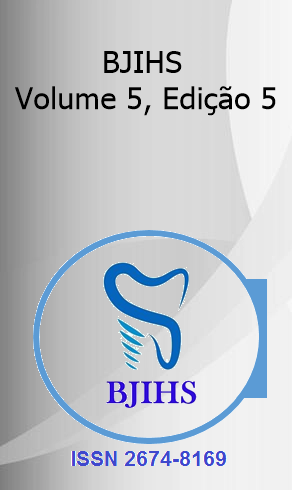Abstract
Caries is a highly prevalent disease throughout the world, especially among children, and its consequence is the dissolution of hydroxyapatite. One compound with the ability to prevent or reduce the incidence of caries is fluoride, so restorative materials with the ability to release this compound have been increasingly developed and studied, as is the case with Beautifil II (GIOMER-Shofu); it is part of the GIOMER family of materials. Objective: This material has raised questions about its mechanical properties, as it has different characteristics and compositions from the most commonly used materials, so it is necessary to establish its real properties and benefits when compared to other restorative materials. Methodology: This study aimed to analyze, by means of an in vitro study, the fracture resistance of a resin with fluoride and other ion release properties (Beautifil II), in comparison with two other materials with the same function. Results: Unquestionably, the strength and longevity of restorative procedures are closely linked to the mechanical properties of the material and its ability to prevent secondary caries. Beautifil II resins from the GIOMER family of materials, a bioactive material that enables the recharge and release of multi-functional ions, using S-PRG (Pre-Reacted Glass Ionomer) technology, promote the release of six other types of ions, each with its own properties, in addition to fluoride. Conclusion: Despite the difference in composition, Beautifil II resins compare well with conventional composite resins (Z350 - 3M).
References
ABDEL-MAKSOUD, H. B. et al. Evaluation of Newly Introduced Bioactive Materials in Terms of Cavity Floor Adaptation: OCT Study. Materials, v. 14, n. 24, p. 7668, 12 dez. 2021.
AL-IBRAHEEMI, Z. A. et al. Assessing Fracture Resistance of Restored Premolars with Novel Composite Materials: An In Vitro Study. International Journal of Dentistry, v. 2021, p. 1–10, 20 ago. 2021.
BAHARI, M. et al. Effects of different etching strategies on the microtensile repair bond strength of beautifil II giomer material. Journal of Clinical and Experimental Dentistry, 2018.
BRITO, A. C. R.; COUTO, C. F. DO; GOUVÊA, C. V. D. DE. Avaliação comparativa da resistência à compressão entre uma resina composta direta e duas resinas laboratoriais. Pesquisa Brasileira em Odontopediatria e Clínica Integrada, v. 7, n. 2, p. 145–148, 2007.
DE ANGELIS, F, VADINI M, CAPOGRECO M, et al. Effect of Light-Sources and Thicknesses of Composite Onlays on Micro-Hardness of Luting Composites. Materials (Basel). 2021 Nov 13;14(22):6849. doi: 10.3390/ma14226849. PMID: 34832251; PMCID: PMC8618162.
FERRACANE, J. L. Resin composite--state of the art. Dental Materials: Official Publication of the Academy of Dental Materials, v. 27, n. 1, p. 29–38, 1 jan. 2011.
GARCIA, I. M. et al. Wear Behavior and Surface Quality of Dental Bioactive Ions-Releasing Resins Under Simulated Chewing Conditions. Frontiers in Oral Health, v. 2, 12 fev. 2021.
GAROUSHI, S.; VALLITTU, P. K.; LASSILA, L. Characterization of fluoride releasing restorative dental materials. Dental Materials Journal, v. 37, n. 2, p. 293–300, 2018.
JAFARNIA, S. et al. Physical and mechanical characteristics of short fiber-reinforced resin composite in comparison with bulk-fill composites. Journal of Oral Science, v. 63, n. 2, p. 148–151, 2021.
KELIĆ, K. et al. Fluoride-Releasing Restorative Materials: The Effect of a Resinous Coat on Ion Release. Acta Stomatologica Croatica, v. 54, n. 4, p. 371–381, 15 dez. 2020.
SHINKAI, K. et al. Dentin bond strengths of all-in-one adhesives combined with different manufacturers’ flowable resin composites. Dental Materials Journal, 2021.
ŞIŞMANOĞLU DDS, PHD, S.; GÜMÜŞTAŞ DDS, PHD, B.; YILDIRIM-BILMEZ DDS, PHD, Z. Effect of Polishing Systems on Fluoride Release and Surface Roughness of Different Restorative Materials. Odovtos - International Journal of Dental Sciences, p. 227–238, 27 set. 2019.
THUY, T. T. et al. Effect of strontium in combination with fluoride on enamel remineralisation in vitro. Archives of Oral Biology, v. 53, n. 11, p. 1017–1022, nov. 2008.
TÜZÜNER, T.; ULUSU, T. Effect of antibacterial agents on the surface hardness of a conventional ionomer cement. Journal of applied oral science, v. 20, n. 1, p. 45-49, 2012.

This work is licensed under a Creative Commons Attribution 4.0 International License.
Copyright (c) 2023 Millena Luiza Vaz da Silveira, Gislene Rodrigues dos Santos, Victor da Mota Martins, Rodrigo Soares de Andrade, Tatiana Carvalho Montes

